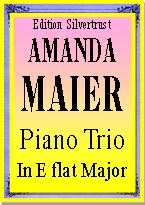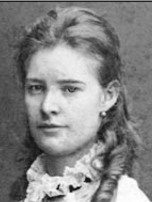Presents
Amanda Maier
 |
 |
SOUNDBITES |
Piano Trio in E flat Major
Amanda Maier (1853-1894) was born in the Swedish town of Landskrona. Her early musical studies on violin and piano were with her father. Subsequently, she studied at the Stockholm Conservatory, winning awards not only for her violin playing but also for her ability on the organ and cello as well as for her compositional ability. After graduating, she continued her studies at the Leipzig Conservatory where she studied composition with Carl Reinecke and violin with Engelbert Röntgen, concertmaster of the Leipzig Gewandhaus Orchestra. While in Leipzig, she composed several works, among them a piano trio and string quartet.. After leaving Leipzig, she spent the next few years touring as a concert violinist before marrying the composer Julius Röntgen, the son of her teacher. Amanda was a fairly prolific composer up until her marriage by which time she a two piano quartets, a piano trio, two string quartets and several other instrumental works to her credit. Most of these works are still in manuscript and several, unfortunately, have been lost. After her marriage she more or less gave up her career. Brahms and Grieg were among those who heard and praised her music highly. Only a few of her compositions were ever published during her lifetime. Her Piano Trio was not among them.
The score to her Piano Trio languished in manuscript form for more that 100 years. It is now located in the Stockholm Theater and Music library from which we obtained a copy. It was begun in 1873 when she was 19 years old and completed the following year by which time she was studying with Carl Reinecke. It is in four movements and begins with a bright Allegro which shows the influence of Robert Schumann. Lyrical episodes are used to break up the energetic sections and provide a fine contrast. A bouncing, playful Scherzo comes next with a much slower and dreamy trio section. Third is a gorgeous Andante which begins with a sad plaint introduced first by the cello and then quickly joined by the violin. This is truly the high point of the trio. The finale, Allego con fuoco, again shows the invisible hand of Robert Schumann. This is almost certainly no accident as Schumann and Mendelssohn were, at the time, the chief models held up by the professors at the Leipzig Conservatory, and none moreso than Carl Reinecke who was Schumann's greatest disciple.
This trio gives ample evidence of Maier's compositional talent and ability and is surely an incredible accomplishment for a 20 year old. Well written from start to finish, it is a pity that it was not published during her lifetime. It deserves concert performance and can also be warmly recommended to amateurs.
Parts: $29.95